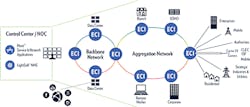Latest from 5G/6G & Fixed Wireless Access/Mobile Evolution
Monetize Your Fiber Investment
3 Surefire Ways to Light Up Your Revenue —
Optical fibers have become affordable enough for forward-thinking infrastructure organizations — from
independent network operators, wholesalers, governments, municipalities, and even local authorities — to lay more capacity than what they’ll likely ever need. However, laying the fiber is just one part of the equation.
The real question remains: how can independent network operators and wholesalers ensure they are effectively monetizing their fiber investments? We believe that, if done correctly, there is now a prime opportunity to provide significant return on investment (ROI).
It’s not just wholesalers and independent network operators looking to get in on the act by investing in fiber. Road and rail companies, governments and municipalities, utility networks, oil and gas companies, and Internet service providers, are all looking to get in on the action. As ultra-fast 5G and fiber-to-the-home (FTTH) and fiber-to-the-premises (FTTP) become more widespread, they’ll reach a symbiotic relationship where they are driving each other’s business case.
Easy As 1, 2, 3
Maximizing fiber investment means selling or leasing extra capacity to other industry players such as connectivity wholesalers, service providers, and traditional network operators. To offer the broadest range as possible of new and existing services means allowing other parties to connect to your fiber in as many ways as possible. Here are 3 key elements in maximizing your revenue potential from fiber-laying investments.
1. Invest in building a multi-service solution to support and aggregate a variety of services to increase potential earning capacity, reduce CapEx, and to ensure ROI.
The path to profitability means realizing different potential customers will be looking to provide different types of services. Many of these requirements will be businesses with mission-critical demands. Think about 5G services that require ultra-low latency to ultra-high reliability. There are other considerations to keep in mind like the plethora of legacy business services using Ethernet VPNs or managed WANs, which are nowhere near end-of-life. These, too, still need connecting.
The point is that when investing in deploying fiber across your network, look beyond access. Look for a solution that has the flexibility to support whatever services your potential customers might want to offer, whether fiber-to-premises, backhaul support, offloading for legacy or business services, and so on. Now might be the time to think about partnering with transport vendors who can help you leverage your fiber network to create a more compelling proposition that goes beyond just fixed or wireless access.
2. Invest in a flexible, programmable, next-generation network.
Future flexibility is key. Whereas current demand is relatively straight forward, 5G will change this. It is crucial to invest in an IP packet and optical network that’s dynamic and programmable and enables huge amounts of data to move flexibly around various access networks. That way, no matter where the demand arises, you are ready for it.
We’d also suggest placing a multi-access aggregation device at the edge of where the access network joins the metro. Then, your network can take any technology or access network coming in, aggregate that data and pass it on to the core. That strategy opens new market potential.
Choosing the right business model.
However, as mentioned, not all aggregation is created equal. So, here’s what you should be looking for:
Agile multi-service aggregation equipment: Look for equipment to transport a variety of services, all in one box. And remember, it’s not just new services.
Scalable equipment: Today, solutions can offer true pay-as-you-grow capabilities, so you can upgrade as needs and demand rise.
Easy to manage: Choose equipment that’s easy to manage, and an infrastructure partner who can make your network operations as intuitive as possible. Today, there are network management systems that are as simple as point and click, and a network expert can help you set up the system and provide any training.
Future-proof: When investing in a system, make sure it’s built to last.
Open and interoperable: As you’ll only be providing connectivity for a certain part of the overall network, you need to ensure you can incorporate your subnetwork into the grander scheme of things.
Basic network architecture.
3. Find the Right Business Model
There are a few options when it comes to laying fiber. You can go dark, lit, or dim — based on your network expertise and resources.
A Dark Fiber Model entails leasing the fiber connection between 2 points, where the customer manages the traffic. This model is often preferred by customers with heavy bandwidth requirements and who have the expertise to run their own network, but who don’t want the added expense of owning their fiber.
A Lit Fiber Model involves providing an interface at the customer location but then managing the optical part of the network for them. Customers (typically enterprises which need large point-to-point bandwidth but that don’t have or want in-house optical expertise) will pay for transport of their service over the network, and prefer to let their local carrier manage all of their networking needs.
A Dim Fiber Model is somewhere between dark and lit, in terms of how much the customer manages.
Wholesale providers and independent network operators are well on their way to making the dream of ubiquitous fiber a reality. But the new challenge at their fingertips is how to monetize those fiber-laying investments and become increasingly attractive to the wholesale carriers and broad public and private sector players bolstering their telecom infrastructure with fiber.
Like this Article?
Subscribe to ISE magazine and start receiving your FREE monthly copy today!
5G is only going to drive the demand for connectivity. This means the revenue is yours for the taking if you, as a wholesale provider, act strategically. With just some additional incremental investment in a proper multi-service aggregation network, ECI Telecom believes you will be much better positioned to move up the value chain.






